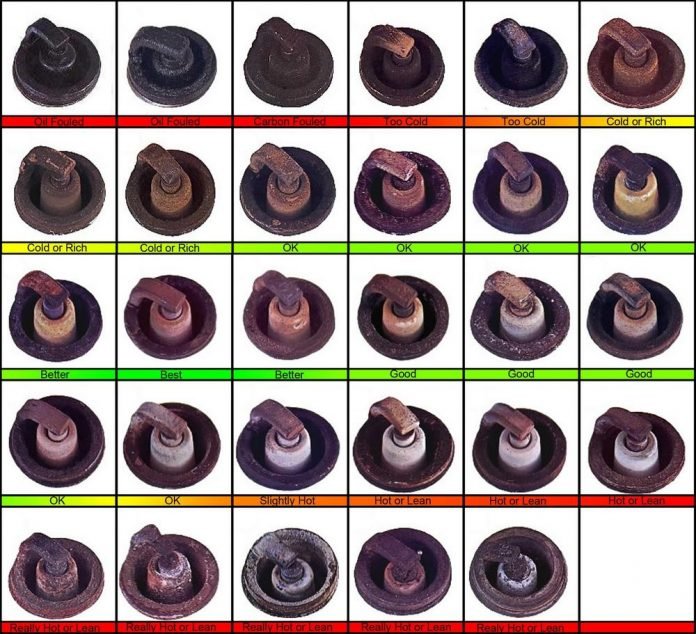Spark Plug When To change
Knowing how to read your spark plug colors can be a valuable aid when giving your engine a tune up. Let’s look at how it’s done.
Your spark plug colors can let you know if your engine is firing properly, or if you’re beginning to run into trouble. There are five basic spark plug colors and condition combinations to judge by.
Grey or slightly discolored spark plug colors are a good indicator that your engine is running properly. When your air and fuel ratio is just right, your spark plugs burn properly and there isn’t a lot of surface build up.
Sooty black, dry spark plug colors and surface conditions would indicate your engine could have one or more problems. Your carburetor may be set too rich, so your plugs don’t burn properly, leaving behind the build up. Your flame arrestor may also be too dirty to work well. Sooty spark plug colors may also indicate a problem with the ignition system causing a weak spark.
Black spark plug colors that look wet in appearance are and indication of fouling. Your oil, or possibly your gas ratio is too high for a proper mix, which keeps the plug from burning the way it should. It’s also possible to get this kind of build up when you only drive in the city. Take your ATV out to reach higher rpm’s, allowing the plugs to burn hotter and burn off the build up.
Chalky, lumpy build up spark plug colors may indicate bad fuel or an oil problem. Always be sure you are using the right grade of oil according to the owners manual. If you can rule this problem out, you might want to look for an oil leak in the combustion chamber.
If your spark plug colors look white, with bubbles or blistering, your plugs are overheating. This could be caused by a gapping or torque problem, as well as an air and fuel mix set too lean. If you can rule these problems out, check your timing, as too fast will cause your spark plugs to burn too hot.
By knowing how to read your spark plug colors, you can catch problems developing early before they do more serious damage to your engine.
Read your spark plug regularly, or at least once every 2 months.
spark plug reading The absolute best way to to get an optimal and correct spark plug reading is by doing the following:
– drive the atv up to its last gear, full throttle
– hit the clutch lever, stop giving gas, and turn off the engine
– take out the spark plug and check its color
This is the most optimal way to read what fuel/air mixture your bike is getting.
Check the spark plug by its color.
fuel/air mixture is too rich: grey, black dry, black wet, chalky, white
fuel/air mixture optimal: coffee with milk
If the spark plug shows a ‘coffee with milk’ color, it doesn’t need replacing and means the fuel/air mixture the bike is getting is correct. Other then that color, the fuel-air mixture is incorrect and needs adjusting. Before you replace the sprak plug with a new one, find and fix the problem, readjust the jetting to assure you won’t have to replace the spark plug again after several weeks.
How to Read Spark Plug Colors(written by Atlantic Jet Sports)
In General: Reading spark plugs can be a valuable tuning aid. By examining the spark plug insulator color, an experienced personal watercraft engine tuner can determine valuable information about the engine’s overall operating condition.
Normal: Grey to Light Golden-Brown Color
- This condition is ideal, the spark plug and engine air/fuel mixture are operating properly.
Dry: Black Black Soot Buildup
- Air/fuel mixture is too rich, the carburetor settings are incorrect, or the flame arrestor is dirty or has mounting problems.
- Spark plug heat range is too cold for the operating conditions.
- Ignition system problems causing a weak or intermittent spark.
Wet Fouling: Shiny, Wet, Black Appearance
- Excessive use of the choke (gas fouled)
- Prolonged low rpm operation (gas or oil fouled)
- Fuel to oil ratio is too rich (oil fouled)
Excess Deposits: Bumpy, Chalky Buildup
- Poor fuel quality
- Oil leakage into combustion chamber
- Improper oil used for premix/injected
Overheated: White, Blistered, Melted Electrode
- Lean air/fuel mixture
- Spark plug heat range is too hot for operating condition of the engine
- Plug is not properly gapped and/or torqued onto head
- Overly advanced timing
A detonation problem would show signs, such as silver specs, black specs, or melting or breakage at the firing tip.
NOTE: Signs of fouling or excessive heat must be traced quickly to prevent further deterioration of performance and to prevent possible engine damage.






